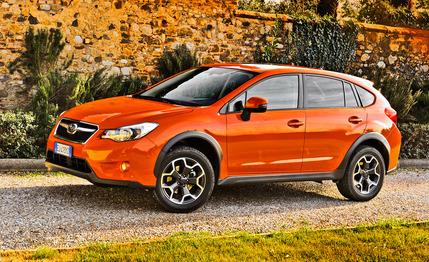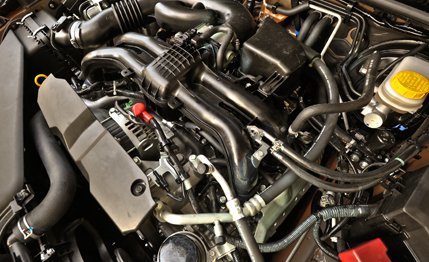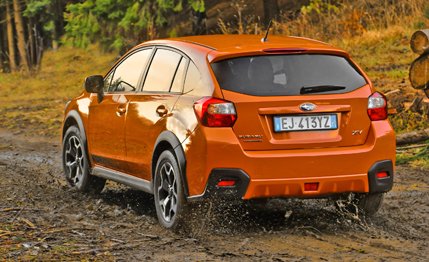
 First Drive Review
First Drive Review
For years, Europeans have ridiculed American buyers for their SUV addiction, but small-SUV sales are booming on the Continent right now. The new XV Crosstrek was conceived as a way for Subaru to capitalize on the trend, its tidy dimensions making it ideal for tight European roads. When U.S. dealers saw the XV, though, they loved it and convinced Subaru brass that it would be a hit with young urban families stateside. Here, it will be known as the XV Crosstrek.
Jesse James has called the Teutuls of Orange County Choppers fame “cake decorators,” alleging that their products are just flashy eye candy and not true customs. He might level the same barb at the XV’s engineers, as the model is really just a lifted Impreza hatchback with new bumpers, some fender cladding, and unique wheels. That’s the same basic formula Subaru followed to create the Impreza-based Outback Sport.
Mooom! He’s Stealing My Sales!
Subaru’s own Forester is 4.1 inches taller, 4.3 inches longer, and no wider than the Crosstrek; the latter’s success likely will depend on how many sales it can cannibalize from the former. The XV will cost a bit more than the Forester, but it will get better fuel economy from its 2.0-liter flat-four than the larger car sees from its 2.5. EPA figures haven’t been finalized—the car isn’t due in showrooms until the fall of 2012—but expect its ratings to be very similar, if not identical, to the Impreza’s. That car is rated at 25 mpg in the city and 33 on the highway with a five-speed manual and at 27/36 with the optional CVT. That’s quite a bit better than the Forester’s 21/27 mpg (of course, the turbocharged Forester gets even worse fuel economy, at 19/24 mpg).


The Crosstrek’s interior being identical to the Impreza hatch’s, it packs the same 23 cubic feet of cargo volume with the rear seats up. Here, the Forester has a clear lead, with 34 cubes. The larger car also betters the XV’s passenger space, with two more cubic feet up front and a significant eight more—49 to 41—in the back. Both the base Forester and XV boast 8.7 inches of ground clearance, or three more than a regular Impreza. Three inches make a big difference when fording the deep snow often found in Subaru-heavy markets such as the Northeast, the Northwest, and the Rocky Mountain states.
Yup: Like a Taller Impreza
As in the new Impreza, the XV’s flat-four is a letdown. With only 148 horses, acceleration is tepid. Plus, the XV transformation adds 50 to 100 pounds to an Impreza wagon. We expect a quarter-mile sprint of 16.8 seconds with the five-speed manual; add a few 10ths with the optional CVT. If the engine were a torque monster, you wouldn’t need to downshift to climb slight grades. But with 145 lb-ft at 4200 rpm, it isn’t, and so you do.
The weak engine lets down a fairly athletic chassis. Like the Impreza, the XV turns in eagerly and is competent when hustled. Raising the body, and thus the center of gravity, does not alter the handling too much. There are a little more body roll and a touch more dive under braking, but these are expected side effects of the loftier ride height. The brakes even took a steep mountain descent without showing signs of fade. Aside from the minimal feedback through the electrically assisted steering, the XV’s chassis is well tuned, and its ride quality falls on the firmer side.


Outside the Subaru showroom, the XV has few natural competitors. The five-door Suzuki SX4 also offers all-wheel drive, but its starting price of $17,764 is a good deal lower than the Crosstrek’s will be. Other all-wheel-drive cars are few, meaning the Crosstrek will primarily battle the equally inexplicable Mitsubishi Outlander Sport and, to a lesser degree, small SUVs such as the Honda CR-V and Toyota RAV4.
If There’s Nothing Below It, Is It Still Premium?
Cost will be a key component of the XV’s success. For 2012, a base Impreza hatch is 18,745, a base Forester is $21,370. Both are offered in three trim levels, but Subaru tells us it will likely offer the XV in just the two upper trim levels, Premium and Limited. At about $22,500, the XV Premium will be a couple grand more than the equivalent Impreza and a bit less than the Forester 2.5 Premium.
Subaru also let us sample the diesel XV it will offer in Europe. Like the gas engine, the oil burner is a 2.0-liter flat-four, but this one gets a turbocharger. The compression-ignition version only gives up three ponies, but torque soars to 258 lb-ft at 1600 rpm. It’s a sweetheart. Plus, it delivers fuel economy that is roughly 25 percent better than the gas 2.0’s. If that sounds like something you’d be interested in, tell your dealer. Apparently, he has Subaru’s ear.